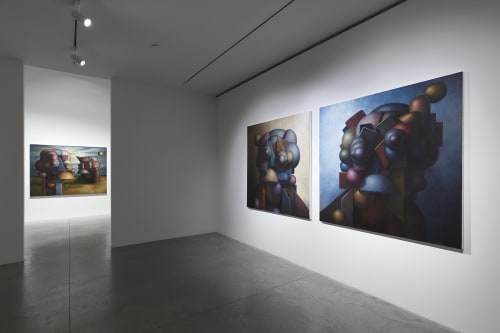Devon DeJardin at Albertz Benda
DeJardin’s exploration into the realm of secular 'guardians' through geometric and anthropomorphic forms places his work in an interesting dialogue with the aesthetic legacies of George Condo and Pablo Picasso. Like Picasso, DeJardin ventures into the abstraction of the human form, yet his approach is distinctively tempered by a modernist homage to figures like Henry Moore and Barbara Hepworth. This results in a synthesis that, while innovative, occasionally treads closely to the edge of being derivative in its quest for originality.
George Condo’s art, known for its frenetic abstraction and the grotesque elegance of its figures, shares a thematic kinship with DeJardin’s guardians. Both artists delve into the psyche, albeit through different visual languages. Condo's work often feels like a carnival mirror reflection of society, where DeJardin's guardians aim to serve as its protectors. However, DeJardin’s reliance on historical motifs and techniques might be viewed as less of a direct confrontation with contemporary chaos than Condo’s approach, which unabashedly merges the absurd with the profound.
Picasso’s influence is palpable in DeJardin’s method of deconstructing and reassembling forms, yet there's a discernible effort in DeJardin's work to anchor his abstractions in a narrative steeped in art history. This contrast with Picasso, whose Cubist innovations were revolutionary in detaching form from narrative to focus on structure and perspective. DeJardin’s paintings, with their historical references and thematic focus on guardianship, seem to seek a middle ground between abstraction and storytelling, which at times might appear as a safer, more retrospective path compared to Picasso’s radical reimagining of form.
The darker palette shift in DeJardin’s recent works, influenced by masters like Goya and Rembrandt, adds a layer of emotional depth and complexity. This evolution reflects a world in turmoil, mirroring the existential angst often found in Condo’s and Picasso’s works. However, the use of historical framing devices and the emphasis on light and shadow to conjure figures from abstract shapes could be seen as relying heavily on the past to articulate contemporary concerns. While this approach undoubtedly produces visually compelling works, it also raises questions about the balance between homage and innovation.
In conclusion, while DeJardin’s paintings are meticulously crafted and rich with historical resonance, there's a delicate line between drawing inspiration and veering towards the derivative. His work is a testament to the enduring influence of giants like Condo and Picasso, yet it prompts reflection on the challenge of forging a truly distinct path in the shadow of such monumental legacies. The narrative power and technical skill evident in DeJardin's work are undeniable, but his journey might benefit from pushing even further beyond the boundaries of his inspirations to explore uncharted territories of form and content.

